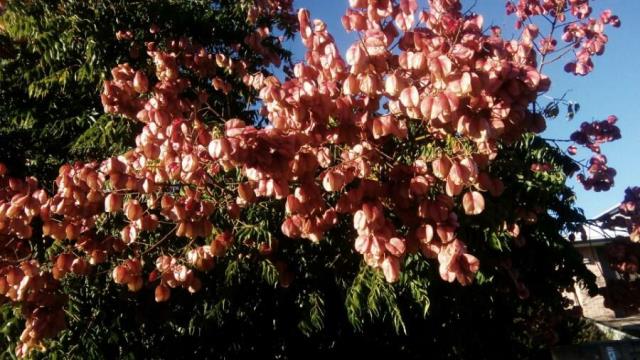By Beatrice Hawkins
The Chinese rain tree is widely used in gardens and as street trees in Warwick where it provides year-round interest, and over the last few weeks has looked really spectacular.
I realise it is an environmental weed in this part of Queensland and in northern NSW, but it is a really attractive tree and not being a dense shade, it is useful in town gardens.
It is easily spread by seeds that germinate readily in six to eight days, but seedlings are easily removed if they come up in a garden or mown off if they come up in the lawn.
A weed is only a plant out of place and I would think that the rain tree only becomes an environmental menace if planted in an area where it can’t be easily controlled – such as a windbreak or shade tree in a paddock.
They tolerate dry conditions well, producing yellow flowers in summer followed by the bright orange/red “paper lanterns” that hold six seeds and hang on, gradually losing colour, all through winter.
It is considered a “city tolerant” tree as it handles pollution, drought, heat and alkaline soils.
The bark is thin and easily damaged, so be careful when mowing and trimming around them.
The wood is brittle and they need pruning when young to make them thicken up and become more dense and attractive.
Another really beautiful plant with spectacular flowers is the Gloriosa lily.
It is a vigorous climber that attaches to the support – provided by means of tendrils – at the end of the stem-less leaves.
It is listed among the most expensive flowers as it sells for $10-$20 per stem.
It is best to plant it in a pot as the tubers/rhizomes tend to spread underground and can be very difficult to remove from open soil.
It needs something to climb on and in my case, it is near a piece of good strong mesh attached to the fence.
They are frost tender but I have found that the plants come up again each year even though the vine will die off in the winter.
Once again it can be a pest and should not be grown in the sandy coastal soil that it loves as it spreads so easily to the detriment of the native plants. The flowers should be removed when spent as the plants can be grown from seed, although it takes from 30-40 days for them to germinate.
The Gloriosa Rothschildiana is a native of tropical Africa and the national flower of Zimbabwe where it is known as the flame lily.
The large, spectacular, pendulous flowers are red with yellow frilly edges and the petals swept back from the flower centre.
The tubers can be guaranteed to flower in the first year and a mature tuber can produce up to 25 flowers – they make an excellent cut flower lasting up to two weeks.
Another very expensive plant with the Rothschild name is the Rothschild’s Orchid valued at about $9500 per plant.
It was only discovered in 1987 and almost became extinct as plant smugglers rushed to trade in it.
Today the only place you can see this beautiful orchid growing in the wild is in the Kinabalu National Park in Malaysia.
Don’t forget the bus trip to the Queensland Garden Expo at Nambour on 8 July.
Join us for a fun-filled, interesting and informative day out. Tickets are available at Danny Lyons and include travel, morning tea and entry to the Expo.
This week I thought I would test your knowledge with a flower quiz.
The questions will be in two parts separated by a hyphen.
1. A continent – a colour. Answer: African Violet
2. Girl’s name – precious metal
3. Controversial singer – grows in a pond
4. To break – Welsh symbol
5. Macropod’s foot
6. Flying mammal – comes after bud
7. What you bounce – boy’s name
8. Often made of glass – used with a dustpan
9. Bird that sings – what a cat does
10. Type of music – underground or open cut.
*This is an old article that has been digitised so our readers have access to our full catalogue.







